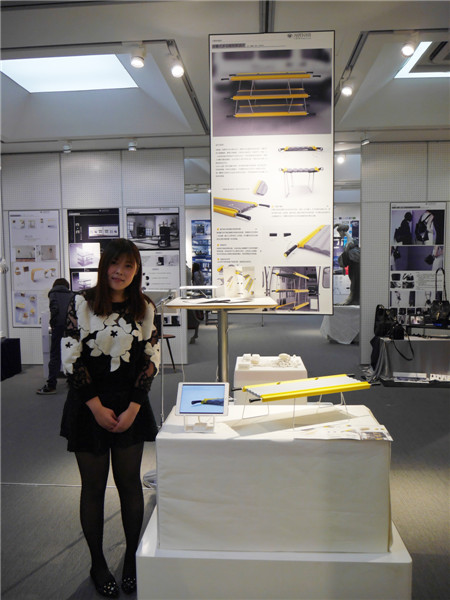Young look to Chinese way of life for product designs
 |
|
Aspiring designer Zheng Difei wins a national award in Hangzhou with her design of a stack-up stretcher. [Photo provided to China Daily] |
The stampede in Shanghai on last New Year's Eve killed 36 people and injured nearly 50, but the tragedy gave Zheng Difei the idea to design a stack-up stretcher.
Zheng, a 22-year-old product designer, was at the Bund in Shanghai a day before the stampede, wondering to herself about the risks posed by such large gatherings of people.
After the incident, the graduate student of the Shanghai-based Donghua University says she felt that if rescue and transportation of the injured had been stepped up, more lives could have been saved. Her solution was the stack-up stretcher that also doubles as a respirator. Oxygen is stored in the stretcher's cushion and flashlights are fitted on its handle.
It can be folded to save on space like regular stretchers.
Her stretcher, still a conceptual product, earned a mention at the 2015 German Red Dot Award competition.
It also won the first prize at Golden Frog Award, a national award for college projects given at the Hangzhou Culture Expo last month.
"I was surprised by it," says Dante Donegani, one of the judges for the Golden Frog Award. He is also the director of the design department at Nuova Accademia di Belle Arti, a Milan-based school of design.
"It is difficult to find a strategy to solve a problem, convey human behavior, have warmth and think of beauty all at the same time," Donegani says. "There is aesthetics and simplicity besides practicality in the (Zheng's) design."
Zheng is not the only aspiring Chinese product designer to impress experts.
Another 22-year-old designer, Zheng Boting, won the grand prize at the International Creative Pattern Design Competition, also held during the Hangzhou Culture Expo.
His work showed the variations on shopping baskets his grandmother used to carry in the olden days. Fish, mushroom and other supplies formed the backdrop of his woven bags.
"Talking about sticking to traditional culture, we often become serious and make products that are detached from daily life," says Zheng Boting, a student at China Academy of Art. "I hope the Chinese way of life is visible in my projects. Not just crafts, but real, down-to-earth life."
"So I want it to be simple," he says. "Design is not about being complex. For me, the simpler, the better."
The basket, still popular among some elderly people, isn't hard to make. But the emotional elements in designing it have made it valuable and attractive in the modern world. Zheng learned the way to weave it from his grandmother, who used to hold the basket in one hand and hold him in the other.
"The feelings behind an object make its design work," he says.
His product message of simplicity won over the judges of the International Creative Pattern Design Competition.
"It is these things you see and the feelings you have that merge to create new languages," says Nicoletta Morozzi, a judge at the competition. She is also the director of the Fashion Area at Nuova Accademia di Belle Arti.
She says young Chinese today are creating such new languages and showing their relationship with their historical past.
In her years of teaching and observing Chinese designers, she says, she has found the younger generations to be eager to bring out their cultural roots in ways that are ingenious and unrestricted.
"Their real deeper cultural roots are coming to the surface," she says.
"The first thing about the pattern is how it captures you and how it conveys its meaning. It is the message, be it big or small, that is the most important."
Meanwhile, the two Zhengs have made it clear that their product designs are not just about looks.
"I would like my designs to be part of people's lives," Zheng Boting says.
"My job as a designer should contribute to society, like helping to save lives," Zheng Difei says.
















